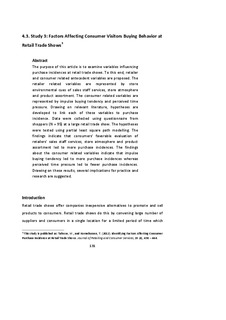Identifying factors affecting consumers purchase incidence at retail trade shows
Journal article, Peer reviewed
Permanent lenke
http://hdl.handle.net/11250/140151Utgivelsesdato
2012Metadata
Vis full innførselSamlinger
Originalversjon
Tafesse, W., and Korneliussen, T. (2012). Identifying factors affecting consumers purchase incidence at retail trade shows. Journal of Retailing and Consumer Services, 19(4), 438-444. doi: 10.1016/j.jretconser.2012.04.005 10.1016/j.jretconser.2012.04.005Sammendrag
The purpose of this article is to examine variables influencing purchase incidences at retail trade shows. To this end, retailer and consumer related antecedent variables are proposed. The retailer related variables are represented by store environmental cues of sales staff services, store atmosphere and product assortment. The consumer related variables are represented by impulse buying tendency and perceived time pressure. Drawing on relevant literature, hypotheses are developed to link each of these variables to purchase incidence. Data were collected using questionnaire from shoppers (N=95) at a large retail trade show. The hypotheses were tested using partial least square path modeling. The findings indicate that consumers’ favorable evaluation of retailers’ sales staff services, store atmosphere and product assortment led to more purchase incidences. The findings about the consumer related variables indicate that impulse buying tendency led to more purchase incidences whereas perceived time pressure led to fewer purchase incidences. Drawing on these results, several implications for practice and research are suggested.
